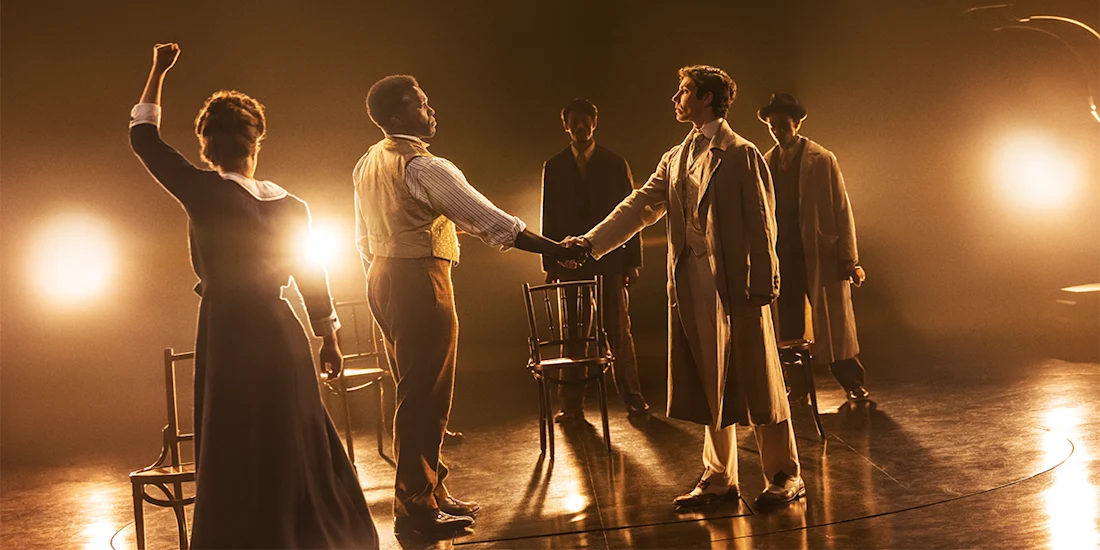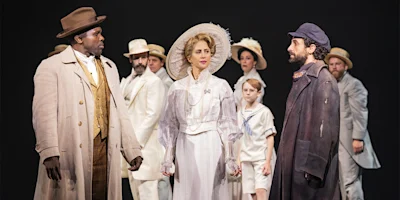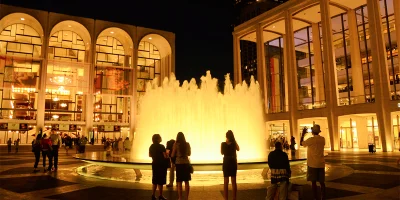
How the rhythm of ‘Ragtime’ changed from page to screen to stage
Before becoming a critically acclaimed musical, now back on Broadway, the sweeping story of Ragtime was told in a bestselling novel and an Oscar-nominated movie.
Summary
- The 1975 book Ragtime by E. L. Doctorow intertwined the stories of fictional New Yorkers from different social groups with real 20th-century historical figures
- Director Miloš Forman's 1981 film adaptation focused on Black pianist Coalhouse Walker Jr. and earned eight Oscar nominations
- The Ragtime musical premiered in 1996 and is now back on Broadway with Lincoln Center Theater
The acclaimed revival of Ragtime at Lincoln Center Theater marks the third time the musical has been presented on Broadway. Things come in threes in many ways for this expansive show.
Ragtime began as a 1975 bestselling historical novel by E.L. Doctorow, which inspired an Oscar-nominated movie adaptation in 1981 before the musical version debuted in Toronto in 1996, and two years later on Broadway. And the story is centered around three social groups — wealthy white suburbanites, the Black community, and immigrants, each chiefly represented by one of three central characters — intertwining in early-1900s New York.
One of Ragtime's most rousing songs, “New Music,” celebrates the energy and innovation of ragtime itself, whose syncopated rhythms and joyful spirit transformed popular music. Find out more about what inspired the Ragtime novel, movie, and musical, and how each version summoned its own new music from the story.
Get Ragtime tickets now.

The Ragtime book (1975)
“In 1902 Father built a house at the crest of the Broadview Avenue hill in New Rochelle, New York.” And so begins E. L. Doctorow's complex novel, inspired by the interior of his home in New Rochelle, New York, built in 1908.
In the early 1970s, Doctorow was searching for an idea for his next book. As he stared at the walls of his house, the author later explained, he imagined what lives might have unfolded inside them and in the surrounding neighborhood. His fascination with American history added another layer to that vision.
Ragtime interweaves the stories of three fictional families: an upper-middle-class white household headed by Father and Mother; Black pianist Coalhouse Walker Jr. and his love, Sarah; and Jewish immigrant Tateh and his daughter. Their paths cross with real historical figures — Harry Houdini, Booker T. Washington, Evelyn Nesbit, and others — blurring the line between history and invention.
Narrated through a voice that shifts quickly among characters, Ragtime becomes a vivid tapestry of American life from 1902 to 1915, when social classes, races, and dreams collided. A bestseller upon release, it won the 1975 National Book Critics Circle Award for Fiction and the American Academy and Institute of Arts and Letters Award in 1976.

The Ragtime movie (1981)
The non-musical film adaptation of Ragtime was directed by Miloš Forman (Hair) and featured Howard E. Rollins Jr. as Coalhouse Walker Jr., Mary Steenburgen as Mother, Elizabeth McGovern as Evelyn Nesbit, and Mandy Patinkin as Tateh among its ensemble cast.
While Doctorow’s novel weaves together several storylines, Forman had a more focused vision and enlisted playwright Michael Weller — known for the 1972 play Moonchildren and the script for the 2015 Doctor Zhivago musical — to make it happen. Working from the book and its many intersecting story strands, the film zeroes in most closely and weightily on Coalhouse’s struggle for justice after a confrontation with racist firemen who destroy his car. The pianist forms a militant group, seizes J.P. Morgan’s library, and seeks retribution.
Ragtime earned eight Academy Award nominations, including nods for Rollins and McGovern in supporting roles, the screenplay, score, and multiple design awards. Though it took home no Oscars, the film was widely praised.

The Ragtime musical (1998)
The Ragtime musical unfurls as an epic tale of a changing America at the turn of the century, with music that’s both evocative of the era and richly theatrical. The score blends the title music genre with jazz, gospel, marches, and more to reflect the cultural diversity of the time.
Created by Terrence McNally (book), Stephen Flaherty (music), and Lynn Ahrens (lyrics), the 1998 Broadway premiere earned eight Tony nominations and won four, for its book, score, orchestrations, and featured actress Audra McDonald as Sarah.
The first Broadway revival followed in 2009, and the current production opened to near-unanimous raves on October 16. The Vivian Beaumont Theater’s massive stage suits the scope of the musical, which has a cast of nearly 40 under Lear deBessonet's direction.
On stage, the musical preserves more of the novel’s breadth than the film, though it necessarily condenses some elements. Coalhouse’s story holds equal importance to Mother’s journey toward independence and Tateh’s pursuit of the American dream and personal success. The three families' stories unfold alongside those of historical figures through sweeping ensemble numbers.
The musical’s opening line echoes the novel’s first words, and song swiftly takes over. Ragtime lets the music tell the story in all its emotional glory. The title number sets the scene — and the stakes:
“It was the music of something beginning, an era exploding, a century spinning, in riches and rags and in rhythm and rhyme: The people called it ragtime.”
Get Ragtime tickets now.
Photo credit: Ragtime on Broadway. (Photos by Matthew Murphy)
Frequently asked questions
Where is Ragtime playing?
Ragtime is playing at Vivian Beaumont Theater - Lincoln Center Theater. The theatre is located at 150 West 65th Street, New York, 10023.
How long is Ragtime?
The running time of Ragtime is 2hr 45min. Incl. 15min intermission.
How do you book tickets for Ragtime?
Book tickets for Ragtime on New York Theatre Guide.
What's the age requirement for Ragtime?
The recommended age for Ragtime is Ages 10+. Children under the age of 5 are not permitted..
What is Ragtime about?
Ragtime is a sprawling story of New York at the dawn of the twentieth century as three families from different backgrounds collide in search of the American Dream.
What are the songs in Ragtime?
The songs feature music inspired by the ragtime genre itself along with soaring solos, duets, and big ensemble numbers including "New Music," "Til We Reach That Day," "Journey On," "Back to Before," and "Wheels of a Dream."
Who wrote Ragtime?
Ragtime is written by a trio of venerable Broadway legends: a lush score by Stephen Flaherty and Lynn Ahrens and a stirring book by Terrence McNally.
Who directs Ragtime?
Tony Award nominee Lear deBessonet directs, marking her inaugural production as Lincoln Center Theater's new Artistic Director.
Is Ragtime appropriate for children?
Ragtime features children in the show, though it does cover themes of death and racism. Children must be four and over to enter Broadway shows.
Is Ragtime good?
Ragtime is a musical theatre classic, winner of multiple Tony Awards, and epic look at American life. It features a grand score and is sure to thrill audiences with its starry cast.
Originally published on







